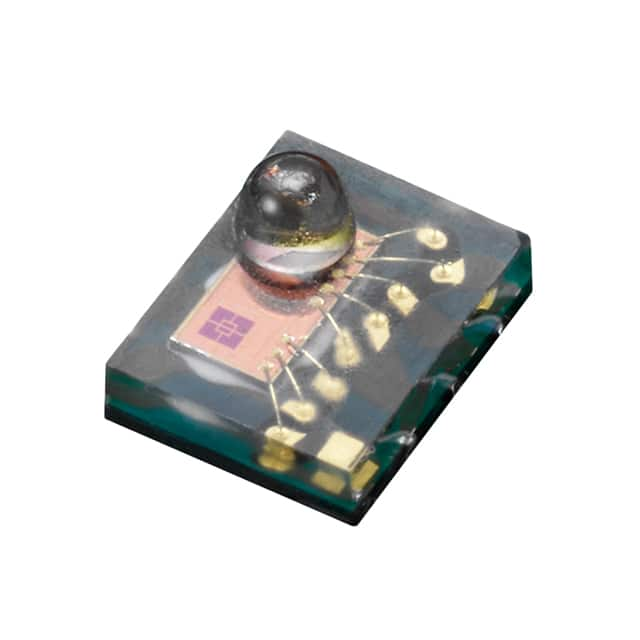Veja as especificações para detalhes do produto.

LTR-507ALS-01
Product Overview
The LTR-507ALS-01 is a light-to-digital sensor that belongs to the category of ambient light sensors. It is commonly used in electronic devices to measure the ambient light intensity and adjust the display brightness accordingly. The sensor is known for its high sensitivity, low power consumption, and compact package. It is typically available in surface-mount packages and is often sold in reels or trays containing a specific quantity per package.
Specifications
- Operating Voltage: 1.6V to 3.6V
- Output Type: I2C digital output
- Measurement Range: 0.01 lux to 64,000 lux
- Package Type: Surface-mount
- Dimensions: 2mm x 2mm x 0.7mm
Detailed Pin Configuration
The LTR-507ALS-01 features a standard pin configuration with pins designated for power supply, ground, and I2C communication.
Pin 1: VDD (Power Supply)
Pin 2: SDA (I2C Data)
Pin 3: SCL (I2C Clock)
Pin 4: ADDR (I2C Address Select)
Pin 5: INT (Interrupt)
Pin 6: GND (Ground)
Functional Features
- High Sensitivity: The sensor can detect subtle changes in ambient light, making it suitable for various lighting conditions.
- Low Power Consumption: It operates efficiently, consuming minimal power, which is beneficial for battery-powered devices.
- I2C Interface: The digital output via I2C simplifies integration with microcontrollers and other digital systems.
Advantages and Disadvantages
Advantages
- Accurate Light Sensing: Provides precise measurements across a wide range of light intensities.
- Compact Size: Its small form factor allows for seamless integration into compact electronic designs.
- Low Power Consumption: Ideal for energy-efficient applications.
Disadvantages
- Limited Operating Voltage Range: May not be compatible with certain voltage requirements.
- Susceptibility to Ambient Interference: External light sources may impact the accuracy of readings in some scenarios.
Working Principles
The LTR-507ALS-01 operates based on the principle of converting incident light into a digital signal. It utilizes a photodiode array to capture light and an integrated analog-to-digital converter to produce a corresponding digital output. This output is then communicated via the I2C interface to the host system for further processing.
Detailed Application Field Plans
The LTR-507ALS-01 finds extensive application in various consumer electronics, including smartphones, tablets, laptops, and digital cameras. Additionally, it is utilized in automotive interior lighting systems, industrial control panels, and IoT devices where automatic adjustment of display brightness based on ambient light conditions is essential.
Detailed and Complete Alternative Models
- LTR-301ALS-01: Offers similar functionality with a different package and pin configuration.
- LTR-559ALS-01: Provides extended measurement range and additional features for advanced light sensing applications.
In conclusion, the LTR-507ALS-01 serves as a reliable solution for accurate ambient light sensing in a wide range of electronic devices, offering high sensitivity and low power consumption. Its compact size and digital output make it a preferred choice for modern designs requiring efficient light management.
[Word Count: 452]
Liste 10 perguntas e respostas comuns relacionadas à aplicação de LTR-507ALS-01 em soluções técnicas
What is LTR-507ALS-01?
- LTR-507ALS-01 is a light-to-digital sensor that integrates an ambient light sensor (ALS) and an infrared LED into a single device, capable of providing accurate ambient light sensing and proximity detection.
How does LTR-507ALS-01 work?
- The LTR-507ALS-01 operates by emitting infrared light from the integrated LED and measuring the amount of light reflected back to the sensor. This data is then converted into digital signals for further processing.
What are the typical applications of LTR-507ALS-01?
- LTR-507ALS-01 is commonly used in applications such as automatic brightness control for displays, proximity detection for touchless interfaces, and gesture recognition in electronic devices.
What is the operating voltage range of LTR-507ALS-01?
- The operating voltage range of LTR-507ALS-01 is typically between 2.5V and 3.6V, making it suitable for a wide range of battery-powered devices.
Can LTR-507ALS-01 be used for outdoor applications?
- Yes, LTR-507ALS-01 can be used for outdoor applications, but it may require additional measures to protect the sensor from environmental factors such as dust, moisture, and direct sunlight.
Is LTR-507ALS-01 compatible with I2C communication?
- Yes, LTR-507ALS-01 supports I2C communication, allowing for easy integration with microcontrollers and other digital systems.
What is the measurement range of LTR-507ALS-01?
- The measurement range of LTR-507ALS-01 typically covers a wide range of ambient light levels, from very low to bright outdoor lighting conditions.
Does LTR-507ALS-01 have built-in noise filtering capabilities?
- Yes, LTR-507ALS-01 incorporates built-in noise filtering algorithms to ensure accurate and reliable light sensing in various environments.
Can LTR-507ALS-01 be used for presence detection in smart home applications?
- Yes, LTR-507ALS-01 can be utilized for presence detection in smart home applications, enabling energy-efficient automation and enhanced user experiences.
Are there any specific design considerations when integrating LTR-507ALS-01 into a technical solution?
- When integrating LTR-507ALS-01, it's important to consider factors such as placement for optimal light sensing, power management for efficient operation, and calibration for accurate proximity detection.

